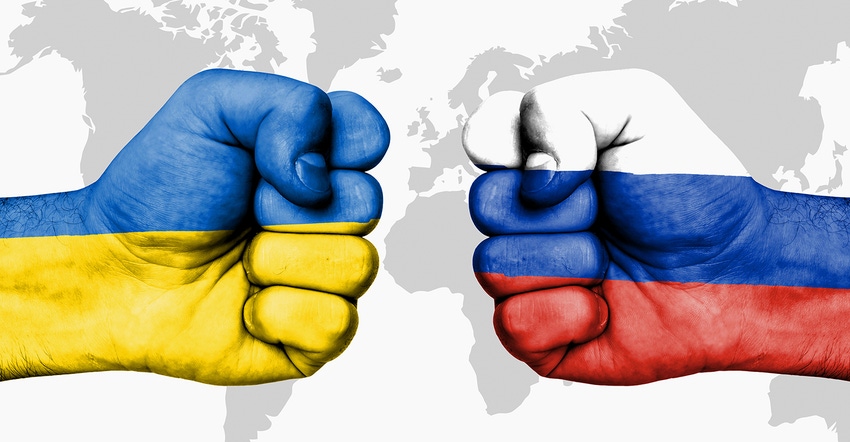
Markets are dealing with extreme volatility due to extreme news that could influence and change the dynamics of supply and demand. These are the times when having a marketing plan is most important, as any one- or two-day mistake could result in a 50 cent to $1.00 per bushel loss.
Any conflict in the Soviet bloc could result in significant changes in the world’s food chain. Insurance on a vessel in a war region will likely skyrocket, causing significant shipping costs. Shipping delays are also possible, as vessels become slow to move due to possible restrictions or inspections.
Sanctions from the West to the east could become as inefficient as the tariff war. In some cases, it could make trade impossible as bank transactions become restricted.
The significance of this is bigger than many have discussed. As can be seen in the tables provided, Ukraine provides 15% of the world's corn compared to the 31% that the U.S. provides. With the current issues in South America, it is unlikely that current demand estimates would be met with a willing supply.
Wheat supplies could be even more difficult to obtain as Ukraine provides 12% of the world's wheat exports, and the U.S. and Russia provide 18%. Thus, a third of the world's wheat exports could be tangled in the mesh of sanctions or military conflict.
The last time Russia invaded Ukraine, most exports were met through the southern and Baltic ports. We do not know how this will play out. We do, however, know that current shippers are discounting values ahead of any conflict in an attempt to push volume out the door.
Complicating matters further, China holds 41% of the world's wheat ending stocks supplies and 69% of the corn. In other words, if the European and Asiatic markets became starved for food/feed stocks, China could be in a position to gain political strength. Just an interesting thought.
South American drought
Drought in South America has been met with some recent rains, and soil conditions have greatly improved as harvest in the southern parts of Brazil and Argentina push forward. Planting of second crop corn advances. However, their supplies are now projected to be below last year's levels. USDA continues to have numbers well above trade estimates, but traders are now assessing the risks of where demand will find needed supply.
We have seen a shift in recent export sales towards the U.S. in recent days. These drought-induced supply losses have become significant enough now that the dynamics have changed. Why? With a 139 – 146 mmt Brazilian soy crop, an increase in U.S. acres in the coming year would not be necessary, and therefore would result in growing ending stocks. The outlook for 2022/23 was negative as long as acres shifted to soybeans and we had a normal yield in the United States. That dynamic has now changed, as the world will need more acres in the U.S. plus a good yield.
Not only has that changed the soybean dynamics, but it leaves the corn industry staring at reduced acres with very strong demand. The tension in these markets has just been ratcheted up. Any drought in the United States this year could cause a sensational move in markets compared to what we normally experience, due to these tightening supplies as well as the macro inflation factors.
Inflation’s consequences
Inflation is a real factor in the inelastic markets of food and fuel. We discussed this in great detail and what the potential consequences are to our markets back in December. We highly recommend re-reading that article.
There are only two ways for this inflation cycle to end. Any conflict of major world players would make it even more difficult for the central banks around the world to manipulate the financial environment towards a soft landing. Monitoring central bank actions is imperative to know whether food and fuel markets will reach levels never imagined and then likely crash -- or if we are currently in the last leg of that push.
Our advice to producers is to take a serious look at the profitability of your operation. It is easy to build a structure where you can lock in and secure your operation’s financial success while at the same time capturing approximately 50% of a further move higher in prices if that happens.
With all the possible scenarios that are on the table, it seems that the person who accepts a strong profit margin while participating in one of the most volatile up moves in our career makes a lot of sense. Because it can all change real fast. The stress and the risk of trying to hit the high seems more like playing a card game and throwing all your chips on the table. That might pay off…. But when we are moving 50 cents a day, that might be a mistake that can cost you dearly. The idea of locking in a profit and still participating in a move higher seems like a better hand.
Contact Bill Biedermann at 815-404-1917 or [email protected].
The risk of loss in trading futures and/or options is substantial and each investor and/or trader must consider whether this is a suitable investment. AgMarket.Net is the Farm Division of John Stewart and Associates (JSA) based out of St Joe, MO and all futures and options trades are cleared through ADMIS in Chicago IL. This material has been prepared by an agent of JSA or a third party and is, or is in the nature of, a solicitation. By accepting this communication, you agree that you are an experienced user of the futures markets, capable of making independent trading decisions, and agree that you are not, and will not, rely solely on this communication in making trading decisions. Past performance, whether actual or indicated by simulated historical tests of strategies, is not indicative of future results. Trading infromation and advice is based on information taken from 3rd party sources that are believed to be reliable. We do not guarantee that such information is accurate or complete and it should not be relied upon as such. Trading advice reflects our good faith judgment at a specific time and is subject to change without notice. There is no guarantee that the advice we give will result in profitable trades. The services provided by JSA may not be available in all jurisdictions. It is possible that the country in which you are a resident prohibits us from opening and maintaining an account for you.
The opinions of the author are not necessarily those of Farm Futures or Farm Progress.
Read more about:
BrazilAbout the Author(s)
You May Also Like






